
- Homepage
- Brand
- Alkota (77)
- Author Doll (38)
- Bestpysanky (28)
- Buyrussiangifts (47)
- Ceprueb Nocag (21)
- Fedoskino Style (15)
- Firebird (17)
- Firebirdworkshop (33)
- Greatrussiangifts (25)
- Hand Painted (14)
- Handmade (922)
- Handmadfe (53)
- Matryoshka (48)
- Nesting Dolls (35)
- Nestingdollsstore (22)
- Russian (50)
- Russian Nesting Doll (16)
- Semenov (18)
- Sergiev Posad (34)
- Unknown (19)
- ... (4811)
- Doll Size
- Ethnicity
- Sport
- Team
- Type
- Action Figure (7)
- Art Toy (4)
- Artist Doll (5)
- Charm(s) (13)
- Doll (24)
- Dolls (4)
- Fashion (5)
- Figure (4)
- Figurine (6)
- Hand Painted (55)
- Lacquer Box (17)
- Light Sculpture (3)
- Matryoshka Dolls (3)
- Nesting (346)
- Nesting Doll (954)
- Nesting Dolls (15)
- Russian (7)
- Russian Dolls (31)
- Set (6)
- Standard (3)
- ... (4831)
UNIQUE Russian nesting 5 DOLLS GOLD Paisley Pattern Blue Red Green Matryoshka
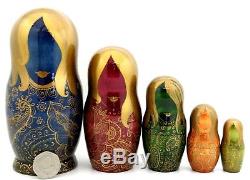
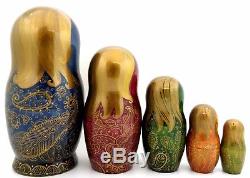
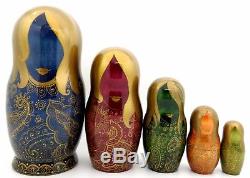
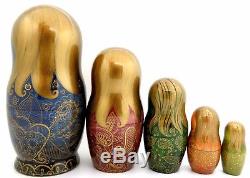
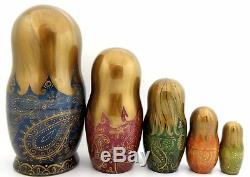
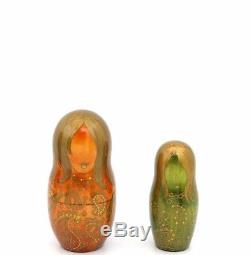
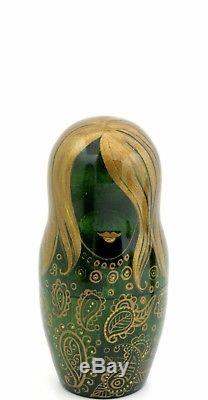

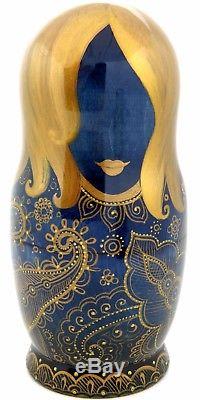


Russian, hand carved and painted wooden set of 5 nesting dolls created by the Russian Artist. The height of the biggest doll is 16.5 cm (6 1/2 inches). Origins of the Paisley: Ancient Babylon in present day Iraq is claimed to be one place of origin of the paisley form.
Another opinion, expressed by Sam Willis in the 2016 BBC TV series The Silk Road, is that the symbol originated from the city of Yazd in Iran. In Yazd originates the weaving of the traditional fabric called a termeh, a cloth made of silk and wool which often included the paisley (boteh) form. Another common theory is that it originated in Persia 200-650 AD during the rule of the Sassanians who created an empire who's armies kept the Romans at bay for centuries.
This empire included what we know roughly as the Middle East, the Caucasus and central Asia. Their culture continues to influence Persian identity right up to the present day (pic 1 - a paisley ornament from Afghanistan C12th-14th).
One of the nicknames for paisley shapes since the 18th century, especially by American quilt makers, was Persian pickles. The symbol can be best described as a similar shape to a curving teardrop or a kidney.
The symbol was called boteh (the Persian word for shrub or cluster of leaves) which is visually a combination of a spray of floral elements and a cypress tree. Centuries later the shape was called Buta almond or bud - the national symbol of Azerbaijan to this day. It could also be an adaptation of the yin-yang symbol used in ancient Chinese medicine and philosophy.Many different cultures have used the paisley symbol and consider it to represent many objects including a cashew fruit, a mango or a sprouting date palm, an Indian symbol of fertility. The symbols shape varies dramatically in different countries from an Indian pinecone to a Russian cucumber. Paisleys can possibly also be traced back to Celtic tradition.
Before the Roman empires influence prevailed in Britain, Celtic patterns were used on many highly-decorated metal objects. The Desborough Mirror (pic 2), discovered at an archaeological excavation in Northamptonshire in 1908, was made in the Iron Age period in Britain around 50BC to AD50. I photographed the mirror at a visit to the British Museum, London in April 2015. The bronze mirrors complex swirling engraved symbols, quite similar to paisley forms, can also be seen in their online collection listing.
Another example of celtic artistic creativity is the Wandsworth Shield. This Iron Age bronze shield which was made in Britain around 200BC has a curvilinear decoration of 2 birds with feathers which resemble paisley shapes. This style of design is called La Tène style and an excellent example which definitely resembles 1960's paisley patterns is an enamel pan from 150AD. The bronze pan (pic 3) is called the Staffordshire Moorlands Pan and is Romano-British. The names of four forts on Hadrians Wall are inscribed along the top of the pan.
The paisley pattern is beautifully coloured in shades of red, yelow and shades of blue. The paisley pattern evolved mainly in The Kingdom of Kashmir. During Mughal Emperor Akbar's reign (15561605), shawl-weaving production increased dramatically.
Its weavers absorbing influences coming across the borders from nearby China, Middle East and India. Woven paisley shawls were mainly worn by men for ceremonies. These early shawls did not display the paisley shape as we know it today but a curving flower with leaves and a stem, the roots of which have striking similarities to Chinese calligraphy. The way in which symbols from different cultures appear in the development of the paisley pattern show how weavers translated artistic influences from imported ceramics, documents, fabrics into their own designs. The East India Company imported paisley shawls (adapted from the Persian word shal) from Kashmir and Persia to Europe in large quantities from around 1800.
The designs were specifically tailored to cater for each regions particular tastes. In Europe the shawls were worn mainly by women not men.The designs might depict exotic scenes of people on elephants riding past palm trees. For the Middle Eastern customers, the curved geometric paisley shape as we know it today was widely used. This was partly due to the Islamic preference not to depict recognisable natural objects. European customers gradually preferred more complicated patterns on their shawls.
Therefore in Kashmir, to speed up the manufacturing process, the patchwork shawl' was invented. Woven pieces of fabric from several looms were joined together to make one shawl. The French Connection: Joseph Marie Jacquard introduced the punch card system to looms in Lyon in 1804, resulting in the first programmable loom. This and other advances in technology during the C19th slowly reduced the high levels of child labour in the textile industries because machinery became larger and more complicated so was unsuitable for children to operate.Prior to the jacquard loom, a child would sit on top of each loom raising and lowering the heddles. His invention made weaving 25 times faster with obviously dramatic increases in paisley shawl output. In 1805, Napoleon and Empress Josephine, his first wife, visited Lyon and viewed Jacquards new loom and granted the patent resulting in Jacquard receiving a royalty for each loom bought. Joséphine, the first wife of Napoleon I, reputedly owned hundreds of cashmere shawls.
These Indian and Pakistani shawls were brought back from Napoleon's campaigns in countries such as Egypt at the beginning of the c. There are many portraits of Josephine wearing shawls similar in style and colour to pic.7 which were the height of fashion and luxury. The creamy ecru colour is the natural colour of the goat's fleece. British shawl production: British production of woven shawls began in 1790 in Norwich, England but to a greater extent in 1805 in the small town of Paisley, Scotland. Roughly equal quantities of imported Kashmiri and home-produced British shawls were bought in Britain in the mid C19th.
The former retained their popularity despite their much higher prices. The main reason being that cashmere is actually hair from a goat and these fine hairs are soft and provide excellent insulation. Cashmere was therefore preferred to sheep's wool which was regarded as much less luxurious. Also the superior Kashmiri looms produced fully reversible fabric with many more colours. Initially the British shawls were only 2-colour, usually indigo and madder.At its peak from c. 1850 -1860 the town of Paisley employed 6,000 weavers. The name "Paisley": Due to the huge scale of shawl production in Paisley, Scotland, the pattern was given the name'paisley'. The name'paisley' is not an international name for the pattern, it is called palme in France, bota in Netherlands, bootar in India and peizuli in Japan. The Scottish town was named Paisley as far back as the 7th century.
The first church was built on the abbey site in 7th century. An ancient Celtic language was spoken in Britain at this time.Paisley derives from the word Passeleg which means'basilica' indicating a major church. The church was given abbey status in 1245.
Parts of the current abbey date back to 1163. William Wallace, the Scottish knight and national hero of Scottish independence was educated in the abbey.
The expansion of the textile industry in the town dates back to the 17th century and is evident with street names which include the words thread, silk, shuttle and cotton. Paisley is part of Renfrewshire, 1 of 32 Scottish councils; it uses the paisley symbol as it's official logo. Popularity: In Britain in the C19th the paisley shawl was the must-have accessory of its day, a status symbol worn for important occasions and recorded in numerous portrait paintings. Until photography had become more available in the late 19th century, paintings recorded fashion trends. These paintings are now a valuable resource for mapping stages in the development of paisley patterns and variations in shawl shapes and sizes.
Ford Maddox Brown's painting pic. William Holman Hunt's painting The Awakening Conscience (1853 - The Tate Britain, London) shows the woman wearing a red paisley shawl draped around her middle and tied at the front, probably brought back by the man from an overseas trip. Paisley patterns, intricate dynamic interlocking shapes in exciting colour combinations appealed to a wide market.
Wool and silk blended yarns were used in Britain, as Tibetan goat hair down was not readily available. A rather unsuccessful attempt was made to rear cashmere goats in Essex, England in 1818. A small herd bred from two imported goats from Kazakhstan only produced very small amounts of the underfleece as the British weather wasn't cold enough.
The rearing was then abandoned. Her work has not just a Amaizing quality finish but also has a beautiful loving warmth to it. All my dolls fit inside one another!! A must have for Russian lovers and it would make an amazing and unique gift for any Occasion or a Very Special Birthday, too good to miss!! Or better yet Be sure to add me to your. And see more unique and interesting things pop up. We speak French , English , German and Russian.Please leave feedback once you have recived the item so that i know it has arrived safely. I will leave feedback in return. Smoke & Pet Free Item. The item "UNIQUE Russian nesting 5 DOLLS GOLD Paisley Pattern Blue Red Green Matryoshka" is in sale since Wednesday, November 08, 2017.
This item is in the category "Dolls & Bears\Dolls, Clothing & Accessories\Russian Dolls". The seller is "tom3burma" and is located in Norwich.
This item can be shipped worldwide.- Brand: Handmade
- Doll Size: 7 in.
- Features: Artist Made
- Number of Pieces: 5
- Country/Region of Manufacture: Russian Federation

